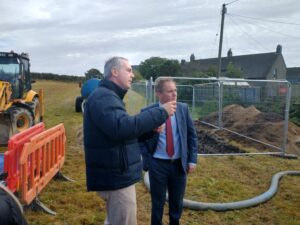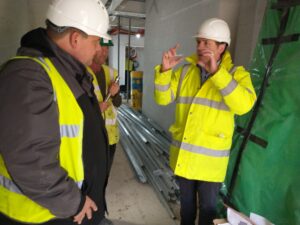
Kensa Utilities, is thrilled to announce that its groundbreaking project, Heat the Streets, has been successful in the category: Green Heat Project of the Year, at the highly esteemed UK Green Business Awards, organised by BusinessGreen. This recognition highlights Kensa Utilities’ commitment to revolutionising the heating industry and its dedication to deployment of sustainable, efficient energy solutions.
The UK Green Business Awards celebrates excellence within the green business sector. The “Green Heat Project of the Year ” category acknowledges some of the most innovative green heat projects in the UK. Kensa Utilities’ ‘Heat the Streets’ project surpassed all expectations and emerged as the clear winner, impressing the judges by bringing affordable low-carbon heating to urban areas with a street-by-street approach.
Heat the Streets was an ambitious project that aimed to decarbonise residential heating across all housing sectors by deploying Kensa’s highly efficient and renewable ground source heat pump technology connected by an in-road network of boreholes (known as a shared ground loop array). The project has successfully demonstrated the scalability and viability of ground source heat pumps connected to in-road infrastructure as a cost-effective solution for reducing carbon emissions and providing reliable, sustainable heat.
Lisa Treseder, Director of Business Development at Kensa Utilities, expressed her pride in receiving the award, stating, “We are honoured and thrilled for Heat the Streets to be recognised at the UK Green Business Awards. This achievement is a testament to the hard work and dedication of our entire team who have been instrumental in making this project a resounding success.”
Treseder continued, “Heat the Streets represents a significant step towards achieving our goal of decarbonising heating at scale. Combining our new business model where Kensa Utilities fund, own and maintain the infrastructure with Kensa’s well-established ground source heat pump technology, we can confidently advance towards the reduction of carbon emissions and the implementation of more efficient heating solutions.”
Kensa Utilities’ Heat the Streets project has also showcased the importance of collaboration between industry experts, local authorities, and community stakeholders. Through strategic partnerships and proactive community engagement, Kensa Utilities has successfully delivered the first iteration of a 21st century version of the gas grid, providing homes in Cornwall with low cost, low-carbon, energy-efficient heating systems whilst improving the quality of life for residents.
As Kensa Utilities continues to expand its influence and shape the future of sustainable heating, this prestigious award reinforces the company’s reputation as a pioneer in the industry. The recognition received at the UK Green Business Awards serves as an encouragement for Kensa Utilities to pursue further innovations and drive the adoption of networked heat pumps on a broader scale.

 Our landmark ground source heat pump project, that has been part funded by the European Regional Development Fund, will see homes within the off-gas village of Stithians, Cornwall, have their existing fossil fuel heating systems replaced with highly efficient, low carbon ground source Heat pumps.
Our landmark ground source heat pump project, that has been part funded by the European Regional Development Fund, will see homes within the off-gas village of Stithians, Cornwall, have their existing fossil fuel heating systems replaced with highly efficient, low carbon ground source Heat pumps. Stithians. One of the lessons from the current situation with Russia and Ukraine is that we must ensure that we increase our energy independence in a sustainable way.
Stithians. One of the lessons from the current situation with Russia and Ukraine is that we must ensure that we increase our energy independence in a sustainable way. Lord Matthew Taylor was on hand in Stithians to officially start the borehole drilling, which is the first step in the installation of the split ownership ground arrays, through which the ground source heat pumps will provide homes with all their heat and hot water.
Lord Matthew Taylor was on hand in Stithians to officially start the borehole drilling, which is the first step in the installation of the split ownership ground arrays, through which the ground source heat pumps will provide homes with all their heat and hot water.
 Heat the Streets will soon enter its most ambitious phase street by street retrofit of ground source heat pumps in the Cornish village of Stithians. Kensa Utilities are replacing existing heating systems in the village with efficient Cornish made heat pumps – with no upfront costs to the homeowners.
Heat the Streets will soon enter its most ambitious phase street by street retrofit of ground source heat pumps in the Cornish village of Stithians. Kensa Utilities are replacing existing heating systems in the village with efficient Cornish made heat pumps – with no upfront costs to the homeowners.